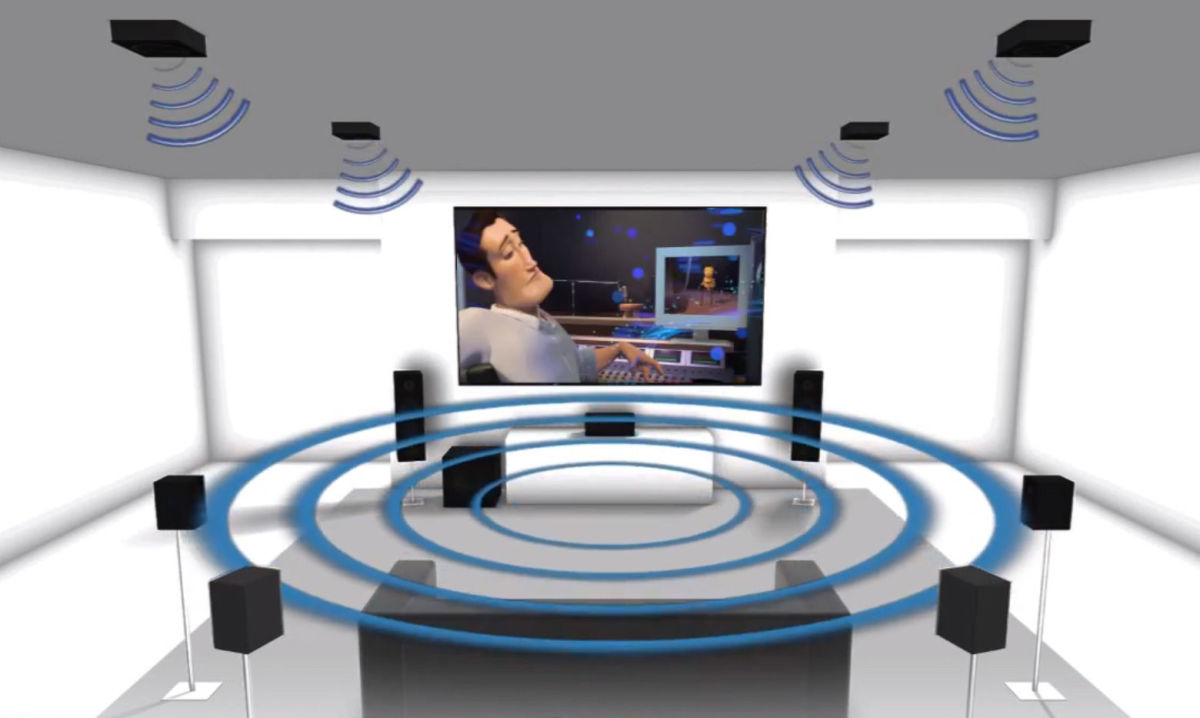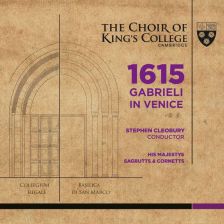Dolby Atmos – taking music into a new dimension
Andrew Everard
Monday, December 7, 2015
The latest recording by the Choir of King’s College, Cambridge, is released in Dolby Atmos sound: what can this extended surround format bring to our musical enjoyment?

‘Last time I saw Last Night of the Proms on telly, the double bassist wasn't running round, let alone flying over the Albert Hall audience…’ wrote an exasperated enthusiast recently, in a hi-fi forum thread discussing the use of Dolby Atmos sound for recorded music. The latest surround format, one of three rival systems being used in cinemas and now coming to home entertainment systems, was clearly in danger of being misunderstood.
Dolby Atmos, along with DTS:X and Auro-3D, takes the existing idea of surround sound, using multiple speakers to give the impression of sound all around you, and moves it into three dimensions. Whereas existing systems have used centre, left/right, and multiple side and/or rear speakers, but all in a flat plane around the room, these new formats add speakers above the audience – ideally in the ceiling – to place the listeners in the centre of a ‘ball’ of sound.
Or at least in a hemisphere, as no-one has yet suggested ‘completing the circle’ with speakers below the listeners, for fairly obvious reasons. Well, I say no-one has, but I do recall a Meridian demonstration at an Audio Engineering Society ‘open day’ in Cambridge some years back, in which 3D sound was demonstrated with speakers both above and below, as well as all around, the audience.
I seem to remember it gave a very uncanny sense of being out in the country at dawn, with birds joining the chorus all around, but also that setting it up had involved rather more scaffolding than most of us would ever want to have in our front rooms.
On a more domestic level, in the past it’s been possible to use processing to give a semblance of height in surround sound, with the use of extra speakers above the front left/right enclosures (and in some cases above the rears, too), these new systems not only use one or two height components – Auro-3D, for example, has the facility for both ‘height’ and ‘top’ channels – but also improved ‘steering’ in the audio mix to give a much more three-dimensional sound, with audio ‘objects’ seeming to appear in space, freed from the speaker array.
So, it’s clear such systems can, with the right speaker set-up, create even more of the ‘theme park ride’ effect required by today’s action movies, if you like doing with the sound what 3D projection has endeavoured to do with the onscreen image. Bullets and helicopters – it’s usually bullets and helicopters – can appear fly over the head of the audience, not just past the head and away into the rear channels, and that disconcerting effect of the creak of a door or a whispered voice is even more unnerving when it seems to come from somewhere you know there isn’t a loudspeaker.
The trouble is, as that commentator I quoted above points out, there aren’t that many flying double basses or singers running from stage left out through the auditorium and into the foyer in classical music, so – as he suggested – surely there’re no place for such gimmickry in classical music recordings?
Couldn’t agree more: I’ll accept the sound of Wagner’s Valkyrie echoing from distant speakers across the sea as that fleet of helicopters come in for the attack in Apocalypse Now – see, bullets and helicopters again! – but such use of ‘special effects’ has no place in recorded music.
Except… the latest recording by that bastion of the choral establishment, the choir of King’s College, Cambridge, has just been released not just on audio-only Blu-ray, but also in Dolby Atmos sound.
Keen to find what out was going on, I set to work finding out how to adapt my current 7.1-channel surround system, mainly used for watching the odd movie, and something of a legacy of the days when I used to review a lot more home cinema equipment, to deliver Dolby Atmos sound. A quick call to a friend, the ever-helpful PR person for Onkyo, revealed that not only did the company have a spare Dolby Atmos receiver I could borrow, but also that it has a cunning solution for those of us not willing or able to start attaching speakers to our ceilings, and running cables up the walls to them.

Onkyo’s Dolby Atmos receiver range starts with the TX-NR636, which sells for around £350 – the company also has a complete system, including all the speakers you need for the effects, for about £700 – so it was the 636 I requested. However, asking for such a product without the promise of a full published review does involve some element of pot luck, and what actually turned up (the next day!) was the company’s TX-NR3030, a £2500 monster receiver – seems it had just come back from review elsewhere, and so happened to be to hand!
Also supplied was a pair of Onkyo’s little SKH410 speakers, which sell for just £129, and are designed to be used atop your usual speakers. Powered from the height channels on an Atmos receiver, and designed to fire upwards, they bounce sound from the ceiling of the listening room, thus giving the impression of the sound coming from above.
Now obviously these little speakers aren’t what you’d normally expect to use with a £2500 receiver (and presumably a conventional speaker system commensurate with those electronics): if you’re serious enough about Atmos to spend that much on processing and amplification, you’d probably be having speakers built into your ceiling, or mounting downward-pointing enclosures. However, as a means of giving me a taste of what Atmos can do, they proved more than adequate.
And what they can do with the King’s College recording, marking the 400th anniversary of the publication of a collection of works by Gabrieli, and the 500th of the complete of the famous chapel at King’s is – rather appropriately – to bring the chapel acoustic into your listening room.
Devotees of the Christmas Eve ‘9 Ls and Cs’, broadcast almost every year since 1928 (1930 was the only one missed) live from the chapel, will have heard much of the sound of the building via the radio. But as one for whom a regular pleasure over the three years I spent in Cambridge was to pop into Kings for evensong (in the ‘low seasons’ away from the Christmas rush!), I can definitely say that on radio you only get a hint of how magnificent the building sounds.
Indeed, in stereo you only get a hint, for what the Atmos system brings to the sound – when being played through seven conventional speakers, a subwoofer and the two height units – is an entirely uncanny sense that the walls and ceiling of the room are dissolved, and replaced by the huge space of that great fan vault above you.
In fact, it completely took me back to dark autumn evenings after the tourists had departed, sitting in the choir stalls with a smallish congregation, and listening to the thrilling way the sounds of voices reverberated around the massive building. Even with a background of singing in choirs in even bigger spaces, I can still remember catching my breath the first time I heard the choir sing in King’s chapel, and it became a regular ‘must do’ whenever family or friends came to visit. Irrespective of faith or musical tastes, none of them left without saying something like ‘amazing’ or ‘incredible’ as we left the chapel and went out into the cold, damp courtyard, lit only by a few lamp-posts along the paths.
And that’s exactly what the Atmos presentation delivers from the recording, on the choir’s own label and presented as a two-disc set: a hybrid CD/SACD, and a Pure Audio Blu-ray. The choir is joined by His Majestys Sagbutts & Cornetts, playing reproductions of instruments of Gabrieli’s time, and the effect of that brass echoing around the space is just as exciting as the voices.

1615: Gabrieli in Venice may be the first classical release in Dolby Atmos, but others have been experimenting with the use of height information for such recording for some time. Notable among these is Norwegian label 2L, whose founder, balance engineer and recording producer, Morten Lindberg has long been recording music to multichannel for SACD and audio Blu-ray release, usually choosing to do so in large concert halls, churches and cathedrals. Recording in 24-bit/352.8kHz DXD (Digital eXtreme Definition), he says that such venues are ‘actually where we can make the most intimate recordings. The qualities we seek in large rooms are not necessarily a big reverb, but openness due to the absence of close reflecting walls. Making an ambient and beautiful recording is the way of least resistance. Searching the fine edge between direct contact and openness; that’s the real challenge.’
Lindberg often records ‘in the round’, with the musical forces arranged around his complex microphone ‘tree’ to take the sound way beyond the idea that the only use for surround in music recording is to kick in a bit of ambience. As he explains it, ‘even when recording a solo instrument, a lot of conservative forces claim that surround sound can add nothing to a good stereo. This might be the case with a traditional dry "synthetic" multi-mono-sources studio recording. But to us it's not about the object itself; it's all about the landscape where the instruments perform.
‘In real life a grand piano is not a point source; it's a three dimensional sculpture, and surround sound is our tool to bring forward that physical experience to the listener.’
That sounds like a pretty powerful manifesto for more lifelike recordings, and in more recent times Lindberg has been recording in Auro 9.1 3D sound, using extra microphones to add the height dimension to the releases. It made its début in 2014 with the release of Magnificat [2L-106-SABD], which he describes as ‘immersive audio, with the addition of height all around the audience.’
He says that ‘Auro-3D is like a sculpture that you can literally move around and relate to spatially; surrounded by music you can move about in the aural space and choose angles, vantage points and positions. Recording in Auro-3D gives me the chance to give the listener the most natural, emotional experience possible.’
Auro-3D is available on some home cinema products, notably selected AV receivers from Denon and Marantz (as an extra-cost upgrade), while a growing number of receivers from the likes of Onkyo, Denon, Marantz, Pioneer and Yamaha are offering Dolby Atmos decoding.
On the speaker front it’s early days for dedicated Dolby Atmos units, but along with the Onkyo speakers mentioned earlier, there are similar up-firing speakers from companies including KEF and Klipsch: KEF has the R50 model at £600/pr, which is somewhat heftier than the little Onkyo speakers, while Klipsch has a both an add-on design, the RP-140SA, and a floorstanding speaker with built-in upward-firing drivers for Atmos.
Or of course you could always ‘bite the bullet’ and install some of the in-ceiling speakers designed for the custom-installation market – just about every loudspeaker company has a range.
If Dolby Atmos, Auro-3D and DTS:X are to catch on, I’m sure their domestic acceptance will be driven by the availability of Hollywood movies on Blu-ray using them, rather than classical music releases. It’s a big ask, given the need to set up systems to suit the various configurations, and the growing recognition that which soundtrack is available on which disc (or indeed receiver) is as likely to be determined by industry politics as customer demand.
However, the sound available on the King’s College Choir release shows that these ‘extended surround’ formats, with their ‘3D’ sound, have much to offer when it comes to the appreciation not only of the music, but the space in which it is performed.
It’s all about the aural clues we pick up almost unconsciously when we listen in a concert hall or church – and nothing to do with flying double basses.
Read the Gramophone review of the new King's College Choir recording: '1615 – Gabrieli in Venice'











